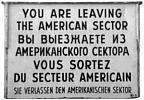Berlin 1959 photos
 Like Germany itself, Berlin was divided into four sectors
of occupation: American, British, French, Soviet. Berlin was inside the
Soviet sector (East Germany, the German Democratic Republic). In 1959, you
could walk right through the Brandenburg gate to East Berlin. No
checkpoints, no guards. Subways ran back and forth too. If you want to see
some good footage of this, I highly recommend these excellent films:
Like Germany itself, Berlin was divided into four sectors
of occupation: American, British, French, Soviet. Berlin was inside the
Soviet sector (East Germany, the German Democratic Republic). In 1959, you
could walk right through the Brandenburg gate to East Berlin. No
checkpoints, no guards. Subways ran back and forth too. If you want to see
some good footage of this, I highly recommend these excellent films:
- The Big Lift (1950). An extraordinary film, shot entirely on location in the ruins of West and East Berlin, about the Berlin Airlift, filmed only 8 years before I flew into Berlin Tempelhof on a DC-4 airliner, civilian counterpart to the C-54 cargo plane used in the airlift, at age 14 when I took these pictures.
- Billy Wilder's One, Two, Three, a Cold War comedy filmed in 1961 (I was still in Frankfurt) just before the Wall went up, 2 years after I took these pictures.
- Decision Before Dawn (1950), about the final months of the war, filmed largely in the ruins Würzburg, Mannheim, and Nürnberg, a joint US-German-Austrian production. It's amazing how much these places were rebuilt between 1950 and 1959-61, when I saw them.
- The Third Man with Orson Welles (1949). Not about Berlin, but Vienna (Wien), which was also divided into four sectors of occupation, like Austria itself and exactly like Germany.
The Kaiser Wilhelm church ruin was preserved as a reminder of the consequences of war. The Reichstag (parliament building) was burned down by Nazis in 1933 (there is still some controversy about this; do a Web search on "reichstag fire" to find lots of material and draw your own conclusions), then blamed on the Communists as a pretext for suspending civil rights and due process. The Soviet War Memorial commemorates the 20 million people of the Soviet Union who died in the German invasion; placing it in West Berlin was a major public relations coup. It was guarded by a small contingent of Red Army soldiers, who marched in solemn slow motion around it. 2500 Soviet troops are buried here. CLICK HERE for a recent large color photo of the memorial. It's still there, but no more Red Army.
- Reference:
-
Berlin
Mitte und die Welt – wie sie einmal war 1914-1989,
P.J. Ortmann, published by the author (2009) (has one of my photos in it). - Also see:
-
Berlin 1961-62
Gallery (contributed by Robert C. Paul).
- Offsite link:
- Soviet War Memorial
Berlin 1959 Photos / Frank da Cruz / fdc@columbia.edu / Created 2001. Most recent update: 7 August 2020
| Created by Photogallery 3.05 August 7, 2020 |








